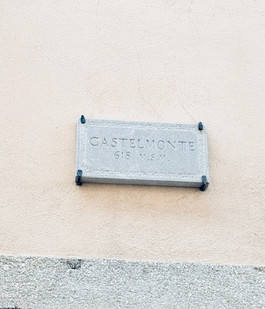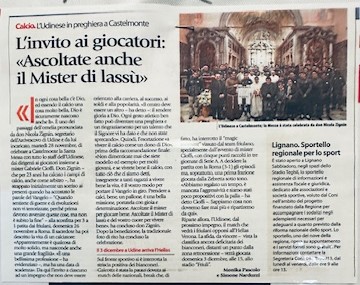Castelmonte Sanctuary – Santuario di Castelmonte
- Maria Scuor
- Aug 28, 2024
- 8 min read
Scorri a basso per l’italiano
Continuing on our day trip with Giorgio, Ursela and Mariasole our next stop was the Sanctuary of the Blessed Virgin of Castelmonte, near Cividale, Udine. Also called Madonna di Mont in Friulano and Stara Gora (ancient mountain) in Slovenian. It is the oldest sanctuary in Friuli and sits 618 metres above sea level in the hamlet of Prepotto, close to the Julian Pre-Alps. It truly is a breathtaking view from the top.
Originally a Roman military post around the 5th century, there were many that took refuge over the centuries, on the top of “Guardia Monte”, a place of sight and defense over the valleys of the Natisone river. Either from hiding from the barbarians that were terrorizing the area, or as a pilgrimage of the Marian cult that were devoted to the Madonna and St. Michael the Archangel, which the first apostolic church was partially devoted to the saint. In 568, the Lombards arrived in Cividale and elected the Archangel Michael their patron saint.
Documentation dated December 20, 1244 mentions Christian pilgrims went in great numbers to Castelmonte to visit the “Santa Maria del Monte”, a safe haven, a fortress surrounded by clear signs of the protection of Mary. In 1253, the property of the Chapter of Santa Maria Assunta in Cividale was united with the Chapter in Cividale. By the 15th century the sanctuary got bigger to accommodate the growing number of pilgrims, who now believed the Madonna di Castelmonte revealed herself as a shield of comfort.
On September 21, 1469, an incredible lightening storm hit and the bell tower, church and sanctuary were reduced to ashes by a furious fire. The nearby population and Canons of Cividale quickly decided to rebuild the entire complex. The work was completed in 1479 and the stone statue of the “Living Madonna” was blessed and is still venerated in Castelmonte.
The Madonna and Child is the heart of Castelmonte. It is made of painted limestone and weighs 400 kg (881 pounds). The crown, the mantle and the throne she sits on represents her regal character. Her face is youthful and pleasant which gave her the name “Madonna bella” and because of her lively and maternal features, she is also called “Madonna viva”. Why the Madonna has dark complexion has led historians to thing of various possibilities but no precise answer has been found. Perhaps it was the personal choice of the artist or ancient Marian icons, which appeared dark because being blackened by time with candle smoke.
Over the years many renovations as well as statues and paintings were added and on December 15, 1798 the sanctuary was given privileges of a Roman Basilica. During the 1st and 2nd World Wars, the area was under fire and many took refuge in the crypt along with the statue of the Madonna. It was July 5th, 1945, when she was returned to the niche and was enlarged and a mosaic was added.
Between 1940 – 1980, the complex took on its current configuration. The façade which was built in 1930 and the bell tower from 1475 went through major renovations during this time as well. Inside the sanctuary are three naves and vault, frescoed by fine artists. The main alter is from 1684 and crafted by Venetian masters. The statue of the Madonna, the Baroque style altars and crypt are beautiful testaments of the times.
Throughout the sanctuary, you will see little and bigger photos as well as little hearts embroideries of the Madonna on the wall with the letters P.G.R. which means Per Grazia Recevuta (For Grace Received). These “ex-votos” are reproductions of a moment in time where a faithful had an accident and by the grace of Mary or God himself were spared a certain death. It is meant to thank them for their protection. It is also to remind us to continue to keep the most important thing “Faith” in our hearts forever. The most important ex-voto is one from the City of Gemona del Friuli in 1576. It was commissioned following the liberation of the city from the plague and made of silver by Giovanni Battista Paduan from Belluno.
Interesting fact is that the Udinese Soccer Club attends a dedicated yearly mass presided by the Archbishop of Udine which this Holy Mass is a thanksgiving for the sporting result that will allow Udinese to continue to play in Serie A and for a positive and serene season. This mass has been held for 29 years, with two years missed due to COVID 19.
2023/2024 season was a very difficult year for the Udinese Soccer Club as on May 26th, 2024, they found themselves in a position of being relegated. Two members of the board of directors of the Udinese Club of Spilimbergo, Michele Molinaro and Nicola Martina, together with Francesca Pagnucco, left the Friuli stadium by bicycle this morning towards Castelmonte. From there, they addressed their prayers to the sky, leaving a jersey as a reminder of this day in which Udinese is called to write an important piece of its history. Thankfully on May 27th, Fabio Cannavaro’s Udinese avoid Serie A relegation.
There are three pilgrimages events that happen every year and brings thousands from Friuli and Slovenia:
September 8, diocesan pilgrimage, in memory of the serious earthquake that hit Friuli in 1976
First week of October, international hill climb race Cividale - Castelmonte
Midnight Mass in the sanctuary on Christmas Eve
The legend of Castelmonte – Thank you to Santuario Castelmonte for the history and me using it in its entirety

Photos of our day at Castelmonte - Foto della nostra giornata a Castelmonte
Exterior of Castelmonte - Esterno di Castelmonte
Interior of Castelmonte - Interno di Castelmonte
Stations of the cross at Castelmonte - Via Crucis a Castelmonte
Ex-Voto including Udinese Jersey - Ex voto comprensivo di maglia dell'Udinese
Family we love - Famiglia che amiamo

Santuario di Castelmonte
Proseguendo la nostra gita con Giorgio, Ursela e Mariasole la nostra prossima tappa è stata il Santuario della Beata Vergine di Castelmonte, vicino a Cividale, Udine. Chiamata anche Madonna di Mont in Friulano e Stara Gora (antica montagna) in sloveno. È il santuario più antico dei Friuli e si trova a 618 metri sul livello del mare nella frazione di Prepotto, a ridosso delle Prealpi Giulie. È davvero una vista mozzafiato dall'alto.
Originariamente postazione militare romana intorno al V secolo, furono molte quelle che si rifugiarono nel corso dei secoli, sulla sommità di "Guardia Monte", luogo di avvistamento e difesa sulle valli del fiume Natisone. Vuoi per nasconderti dai barbari che terrorizzavano la zona, vuoi come pellegrinaggio del culto mariano che era dedicato alla Madonna e a San Michele Arcangelo, a cui la prima chiesa apostolica era parzialmente dedicata al santo. Nel 568 i Longobardi giunsero a Cividale ed elessero l'Arcangelo Michele loro patrono.
La documentazione del 20 dicembre 1244 menziona che i pellegrini cristiani si recavano in gran numero a Castelmonte per visitare "Santa Maria del Monte", un porto sicuro, una fortezza circondata da chiari segni della protezione di Maria. Nel 1253 la proprietà del Capitolo di Santa Maria Assunta di Cividale fu unita al Capitolo di Cividale. Nel XV secolo il santuario si ingrandì per accogliere il crescente numero di pellegrini, che ormai credevano che la Madonna di Castelmonte si rivelasse uno scudo di conforto.
Il 21 settembre 1469 si abbatté un'incredibile tempesta di fulmini e il campanile, la chiesa e il santuario furono ridotti in cenere da un furioso incendio. La popolazione vicina e i Canonici di Cividale decisero rapidamente di ricostruire l'intero complesso. L'opera fu completata nel 1479 e la statua in pietra della "Madonna Vivente" fu benedetta ed è ancora venerata a Castelmonte.
La Madonna col Bambino è il cuore di Castelmonte. È realizzata in pietra calcarea dipinta e pesa 400 kg. La corona, il mantello e il trono su cui siede rappresentano il suo carattere regale. Il suo viso è giovanile e gradevole, il che le ha dato il nome di "Madonna bella" e per i suoi lineamenti vivaci e materni, è chiamata anche "Madonna viva". Il motivo per cui la Madonna ha la carnagione scura ha portato gli storici a pensare a varie possibilità, ma non è stata trovata una risposta precisa. Forse era una scelta personale dell'artista o antiche icone mariane, che apparivano scure perché annerite dal tempo con il fumo delle candele.
Nel corso degli anni furono aggiunti numerosi restauri, statue e dipinti e il 15 dicembre 1798 al santuario furono concessi i privilegi di basilica romana. Durante la 1° e la 2° Guerra Mondiale, la zona fu sotto tiro e molti si rifugiarono nella cripta insieme alla statua della Madonna. Era il 5 luglio 1945 quando fu riportata nella nicchia e fu ingrandita e fu aggiunto un mosaico.
Tra il 1940 e il 1980 il complesso assunse la configurazione attuale. Anche la facciata, costruita nel 1930, e il campanile del 1475 subirono importanti ristrutturazioni durante questo periodo. All'interno del santuario sono a tre navate e volta, affrescate da artisti di pregio. L'altare principale è del 1684 ed è realizzato da maestri veneziani. La statua della Madonna, gli altari in stile barocco e la cripta sono bellissime testimonianze dei tempi.
In tutto il santuario si possono vedere foto piccole e grandi e piccoli cuori ricamati della Madonna sulla parete con le lettere P.G.R. che significa Per Grazia Recevuta. Questi "ex-voto" sono riproduzioni di un momento nel tempo in cui un fedele ha avuto un incidente e per la grazia di Maria o di Dio stesso è stato risparmiato una morte certa. Ha lo scopo di ringraziarli per la loro protezione. È anche per ricordarci di continuare a mantenere la cosa più importante, la "Fede", nei nostri cuori per sempre. Il più importante ex-voto è quello della Città di Gemona del Friuli del 1576. Fu commissionato in seguito alla liberazione della città dalla peste e realizzato in argento dal bellunese Giovanni Battista Paduan.
Fatto interessante è che l'Udinese Calcio partecipa ad una messa annuale dedicata presieduta dall'Arcivescovo di Udine che questa Santa Messa è un ringraziamento per il risultato sportivo che permetterà all'Udinese di continuare a giocare in Serie A e per una stagione positiva e serena. Questa messa si tiene da 29 anni, con due anni persi a causa del COVID 19.
La stagione 2023/2024 è stata un anno molto difficile per l'Udinese Calcio, che il 26 maggio 2024 si è trovata in una posizione di retrocessione. Due membri del consiglio direttivo dell'Udinese di Spilimbergo, Michele Molinaro e Nicola Martina, insieme a Francesca Pagnucco, hanno lasciato questa mattina lo stadio friulano in bicicletta alla volta di Castelmonte. Da lì, hanno rivolto le loro preghiere al cielo, lasciando una maglia a ricordo di questo giorno in cui l'Udinese è chiamata a scrivere un pezzo importante della sua storia. Per fortuna, il 27 maggio, l'Udinese di Fabio Cannavaro evita la retrocessione in Serie A.
Sono tre i pellegrinaggi che si svolgono ogni anno e che portano migliaia di persone dal Friuli e dalla Slovenia:
8 settembre, pellegrinaggio diocesano, in ricordo del grave terremoto che colpì il Friuli nel 1976
Prima settimana di ottobre, gara internazionale in salita Cividale-Castelmonte
Messa di mezzanotte nel santuario la vigilia di Natale
La leggenda di Castelmonte – Grazie al Santuario Castelmonte per la storia e per averla utilizzata nella sua interezza









































































































Comentários